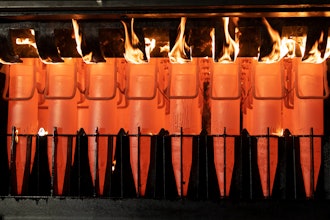
Rochester Drug Cooperative (RDC) is the seventh largest wholesaler in the United States and the fastest growing distributor of its kind, serving over 1,000 pharmacies and related stores in the Northeast with a complete inventory of healthcare supplies.
Until the summer of 2015 RDC served all its customers, spread over five states, from its headquarters distribution center in Rochester, NY. But as the business continued to expand, RDC purchased a former JC Penney warehouse in Fairfield, NJ to serve the greater New York City market, which had grown to approximately two-thirds of its $1.8 billion in annual sales.
Always on the leading edge of technology-driven logistics, RDC spent eight months turning the facility into a highly sophisticated, automated distribution center. It began serving customers from the new location in July 2015. The primary additions included an A-Frame automated product picking system, an extensive system of conveyors and carousels, and a 10,000 sq ft mezzanine, increasing the total warehouse size to 106,000 sq ft.
While the mezzanine itself may be the least sophisticated of the warehouse additions, it is the hub of the automated picking operation at the new facility.
Automated Picking Operation
The totes that gather the individual store orders are first introduced to the system on the mezzanine, along with a code that identifies their unique product selections for the day. Once the totes have been routed through the maze of conveyors to gather the requisite products on the ground floor, they pass through the mezzanine again for quality control checks and the insertion of any paperwork and promotional materials before they are conveyed to the truck loading area.
Though the active totes come and go through the intricate conveyor system, the central supply route that keeps the mezzanine hub in operation is a Series 21, two-post hydraulic material lift from PFlow Industries Inc. Commonly known as a vertical reciprocating conveyor (VRC), the lift provides a safe and reliable means to keep the mezzanine supplied with the reusable totes that come back from the field and the numerous consumable materials integral to the order fulfillment process.
"We have a PFlow VRC at the Rochester facility that serves a similar purpose, so when we were designing the new warehouse in New Jersey the VRC was spec'd in from the beginning. It is an essential piece of the warehouse infrastructure," said Gary Ritzmann, the RDC project manager in charge of building and commissioning the new distribution center.
"For safety and efficiency it is far better to transport materials to the mezzanine with the VRC, with its two full pallet capacity, than a forklift, a partial pallet at a time. Plus, the mezzanine is almost 14 ft high, so using a forklift is precarious at best, and we are trying to keep motorized vehicles away from all order processing equipment."
Successfully Addressing Challenges
The VRC was specified and installed by Atlantic Handling Systems (AHS), a full service material handling equipment provider in Fair Lawn, NJ. AHS designs systems and provides equipment to move, lift, and store materials in most any type of commercial facility. In addition to the PFlow VRC, AHS also installed all pallet racking and shelving in the new warehouse.
"There were some challenges in installing the VRC in Fairfield. With the lift positioned right up against a shipping sortation conveyor, we had to build a small deck extension from the mezzanine over the conveyor to bridge the gap to the VRC gate on the upper level," commented John Cosgrove, AHS president. "Plus we had to build the deck and install the lift just after RDC had already begun its distribution operations. It definitely took some coordination and delicate maneuvering."
PFlow custom builds all VRCs to the specifications of each customer. The RDC Series 21 has a 3,000 load capacity, and an 8 ft wide x 5 ft long x 7 ft clear height lift carriage, enough to handle full two pallets of empty totes or consumable supplies. It features a vertical acting gate on the ground floor and a bi-panel gate on the second floor. With the gates configured in a Z-pattern, products are loaded on one side on the ground floor, and unloaded on the opposite side on the mezzanine.
Materials make the 13 ft 6 in. travel distance from the ground floor to the mezzanine at a speed of 24 ft per minute, a duration of approximately 30 seconds. The pallets are loaded and unloaded with a manual pallet jack. RDC runs a product receiving shift during the day and a product picking shift in late evening and early morning. The VRC is primarily used during the receiving shift, making at least a dozen trips per shift.
The carriage is lifted and lowered by two hydraulic cylinders, mounted on the guide columns that straddle the carriage. The hydraulic technology provides cost-effective durability, allowing the lifts to operate continuously throughout the day, with installation costs and maintenance needs less than other lifting technologies.
"Atlantic Handling was a great partner in the Fairfield project, providing support in many aspects of the project," said Ritzmann. "They did a lot of design work, and they helped us find some special fork trucks that allowed us to navigate a narrower layout of aisleways, which helped to optimize the space in the building."
Ironically, Ritzmann is very familiar with the VRC industry, having worked at Langley Lift near Rochester before the company's assets were purchased by PFlow.
"I sold and installed hundreds of VRCs over a five-year period. I know the industry and who has the best product," said Ritzmann. "The PFlow lifts in both Rochester and Fairfield are top of the line, they have worked perfectly."
The steady growth of RDC's business that required the new distribution center has not abated. Business expansion in Delaware, Maryland, and points south will soon be served from Fairfield, as will more customers in New York State. In coming months the Rochester facility will focus on growth in Pennsylvania, Ohio, and Massachusetts.
VRCs move materials, but not people, between multiple levels in factories, warehouses, institutions or anywhere that products or supplies need to move from one level to another. They have their own national code (ANSI/ASME B20.1) and are specifically exempt from the national elevator code.























